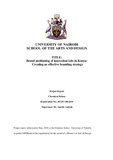Brand positioning of innovation labs in Kenya: Creating an effective branding strategy

View/
Date
2018-05Author
Cheruiyot, Nelson
Type
ThesisLanguage
enMetadata
Show full item recordAbstract
Innovation labs or hubs are social workspaces and research centers that provide specific expertise on trends and innovation management. Globally, innovation labs have been used by governments, non-governmental organizations, research institutions, multinational corporations and think tanks to foster collaborative innovation and realize systemic change. Such labs are on the increase in Kenya’s creative intellectual landscape. The Kenyan government for example aims to have four innovation hubs in each county. Given that innovation labs have unique offerings targeting niche clientele, it is expected that they would create a differentiated status in the creative intellectual landscape. Additionally, such labs often depend on external funding and therefore need to increase their visibility in an increasingly competitive innovation space. Despite this need, it is unclear how innovation labs in Kenya can be effectively branded to create differentiated and visible offerings to attract clientele and influence stakeholders. Arguably, building a brand for any organization providing a product or service has been aimed at achieving a differentiated status in an ever increasingly competitive market. As such, organizational values, core values, and added values have become central to brand identity, growing beyond the straight forward outlook of an organization. The overall objective of this study therefore, is to establish how innovation labs in Kenya can create effective brand strategies. The researcher proposed using the AC2ID framework and is done at two levels: First, the AC2ID framework is used to identify the branding strategy. The findings from this evaluation are then used to propose an effective branding strategy based on the Design Management model. The AC2ID framework elaborates the diverse stakeholders of a brand identity and is therefore suited to identify and evaluate a branding strategy. The research was based on a case study of C4D Lab based at the University of Nairobi School of Computing. The lab was comparatively studied to iHub which is Kenya’s leading independent innovation lab. The Design management model is a design tool that creates a cohesive brand experience and is therefore an ideal tool for shaping an effective branding strategy. A semi-hypothetical case study (Living lab) is used to illustrate the design of a brand experience. Ultimately, this
study is groundbreaking in as much as it paves way for the theoretical and systematic understanding of innovation lab brands.
